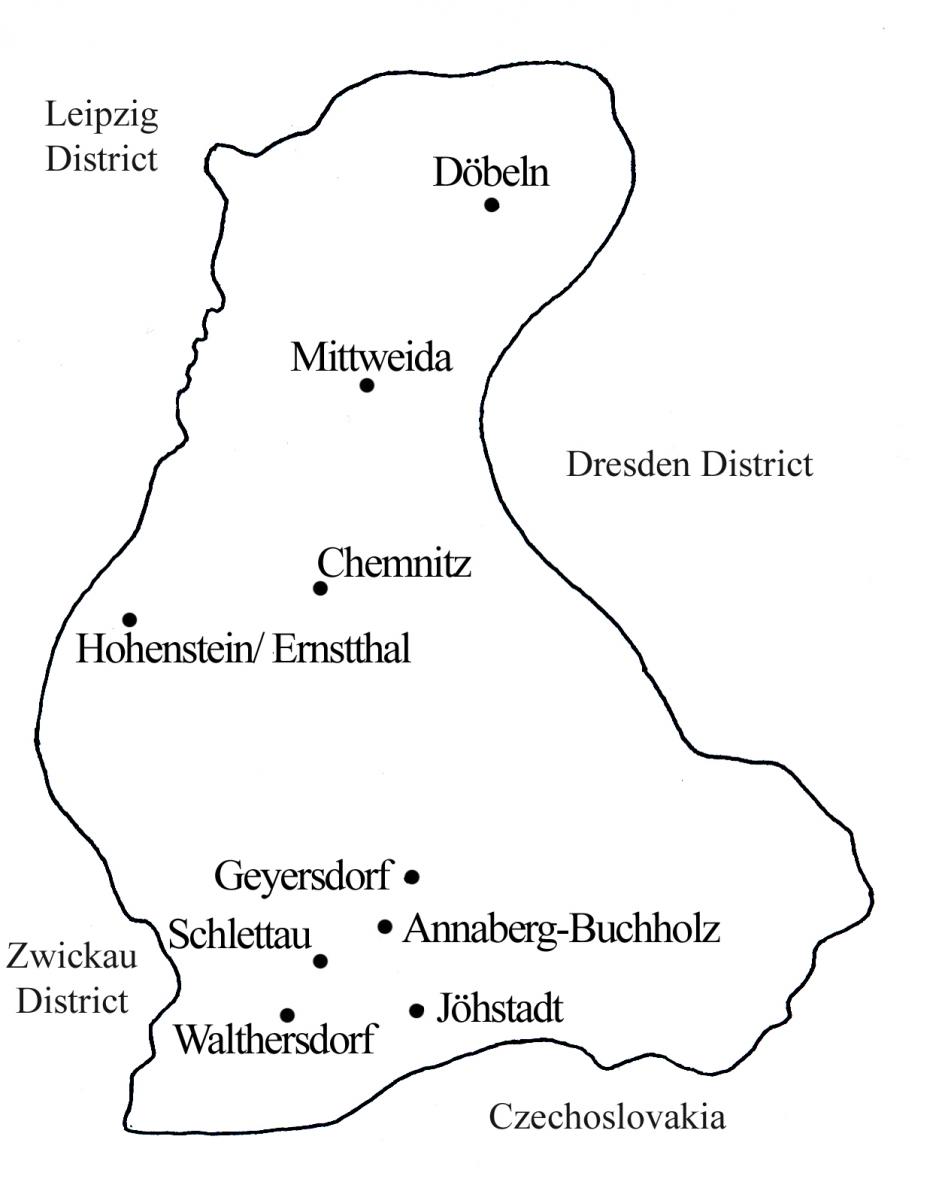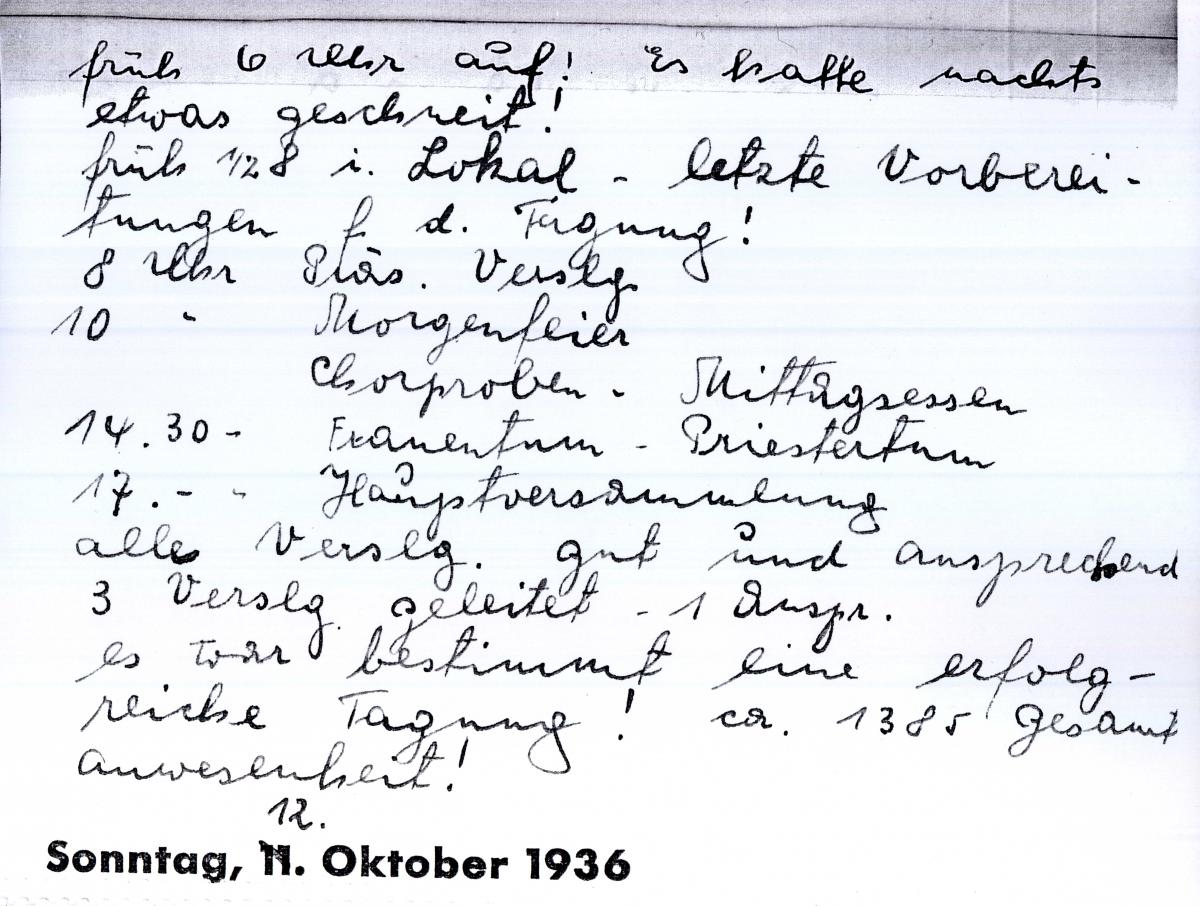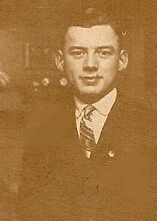Chemnitz District
Roger P. Minert, In Harm’s Way: East German Latter-day Saints in World War II (Provo, UT: Religious Studies Center, Brigham Young University, 2009), 153-6.
With a total of 1,051 members, the Chemnitz District was the second largest in the East German Mission at the onset of the year 1939. The district consisted of six branches, all of which were situated in south-central Saxony. The city of Chemnitz with two branches (Center and Schloss) had long been a bastion of the Church in eastern Germany. The city is located about 150 miles south of Berlin.
Because of the high concentration of Latter-day Saints in the area, the Chemnitz District territory was even smaller than the Berlin District. Branches were located in Döbeln (twenty miles northeast of Chemnitz), Mittweida (ten miles north), Hohenstein/
 The Chemnitz District was in the heart of the old Kingdom of Saxony in eastern Germany.
The Chemnitz District was in the heart of the old Kingdom of Saxony in eastern Germany.
In 1938, a mission directory showed that four small groups of Saints were also meeting in towns within the Chemnitz District:
| Town | Host Family | Address |
| Geyersdorf | Wagner[1] | Hauptstrasse 92, main floor |
| Jöhstadt | Meyer | Innere Bahnhofstrasse 122 |
| Schlettau | Hofmann | Markt 45 |
| Walthersdorf | Petzold | Adolf Hitler Strasse 6, upstairs |
Very little is known about those small groups of Latter-day Saints.
| Chemnitz District[2] | 1939 | 1940 | 1941 | 1942 |
| Elders | 45 | 56 | ||
| Priests | 32 | 22 | ||
| Teachers | 42 | 43 | ||
| Deacons | 54 | 54 | ||
| Other Adult Males | 192 | 194 | ||
| Adult Females | 596 | 599 | ||
| Male Children | 41 | 46 | ||
| Female Children | 49 | 48 | ||
| Total | 1051 | 1062 | 1058 | 1022 |
The East German Mission history has the following entry dated Sunday, May 29, 1938:
On this and the previous day, the annual spring conference of the Chemnitz District was held in Chemnitz. Mission Pres. Alfred C. Rees, and the Elders of the district were in attendance. The choir, with the help of an orchestra, rendered some very beautiful musical selections. The meetings were well attended.[3]
Karl Göckeritz of the Chemnitz Center Branch was the president of the Chemnitz District. His counselors in 1939 were Paul Langheinrich and Emil Heidler. Although a relatively young man (born in November 1909), President Göckeritz was called by one elder “the driving force in all of the branches in the district.”[4]
President Göckeritz kept a diary for just more than a year, beginning in early 1941. He used a diary printed for the year 1936 and simply revised the date at the bottom of the page. The entries are very detailed and indicate a wide variety of family, church, occupational, and cultural activities. He even made frequent comments regarding the weather. The following are extracts from his diary:
Wednesday, March 19, 1941: Police monitored our building tonight regarding the blackout regulations.
Sunday, April 7, 1941: Very early wrote Church letters. Took Hannchen [wife Magdalena Johanna] and children to Center Branch. Train to Döbeln at 10:56. Gave talk and played music. On to Mittweida at 2:17. Visited Emmerlichs. Rehearsal at church. Gave talk and played music. Home about 10:00 p.m.
Sunday, May 4, 1941: Conference. Went to church at 8:00 a.m. Everything is ready! Wonderful morning session. Superb decorations. Everything went very well. Choir practice. Solved all problems. Preparations for afternoon session. All went well. Then main session! 506 in attendance. Beautiful! Everything went well. The room was totally full! Gave one talk in each meeting and one prayer. Evening at home with Brother [Richard] Ranglack [from the mission office in Berlin]. Everything was wonderful!
Tuesday, May 20, 1941: Afternoon funeral service for soldier W. Opitz. Military ceremony. Very impressive! Evening in Central Theater for Paginini. Very nice. Heavy rain!
Saturday, May 31, 1941: Express train at 6:25 a.m. to Berlin. Great weather. In Berlin about 11:00 a.m. Walked to mission office. Met the people from the West German Mission: Brother and Sister Heck, Brother Huck, Sister Weipel, and Ilse Krämer. . . . Evening meeting at Hufelandstrasse [Berlin Center Branch]. Fine meeting!
Wednesday, June 25, 1941: Office work! Nothing special! Went to the dentist. In the evening wrote reports, then to Center Branch. Resolved various matters there. Rudi Seltmann killed in an accident near the Russian border.
Sunday, August 10, 1941: Took children to Sunday School early. Resolved some Church matters there. Rode my bicycle to Stollberg to take care of some matters there. Home with children. In the afternoon rainy weather! Took a nap. Then to Center Branch to speak with Brother Urban regarding members in Bohemia [Czechoslovakia]. Took care of some matters in Center Branch. Played [the piano] because nobody else was there.
Tuesday, September 2, 1941: Two hours of air-raid alarm during the night.
Friday, September 5, 1941: Held a baptismal ceremony. Six persons baptized, two confirmed. Very nice. Gorgeous summer evening!
Friday, September 12, 1941: In the evening to Center Branch. Construction work in upper room with Alfred Schulz, Oskar Bonitz, Lothar Cieslak. Really dirty work. Had a bath later.
Sunday, October 12, 1941: Got up at 6:00! It snowed during the night! To church at 7:30. Last-minute preparations for the conference! 8:00 presidency meeting. 10:00 morning session. Choir practice. Lunch. 2:30 Relief Society and priesthood meeting. 5:00 main session. All meetings had good attendance. I conducted three meetings and gave one talk. It certainly was a successful conference! Approximately 1,385 total attendance![5]
On October 17, 1941, the district presidency sent a letter to soldiers in the field:
Once again we have had a conference in the rooms you know so well, at Schadestrasse 12. Our district conference! Just as the earth has yielded the blessings of Almighty God through a fine harvest, so do we experience the goodness of our heavenly Father in rich measure. . . . Although we cannot see you, we are still spiritually very closely connected with you. Just picture it: there was not an empty seat in the room. . . . As God lives, so lives His work. We greet you as loyal brethren in the gospel. Our fondest wishes accompany you. We ask the Lord every day to protect you, so that you may return in health to your homeland. May peace fill the earth very soon, so that all peoples may be joined in a righteous labor. . . . All of the branches you know are functioning as before: Annaberg-Buchholz, Chemnitz Center, Schloss, Döbeln, Hohenstein, Mittweida. The wheel of truth continues to turn. . . . Be of the conviction that we are always thinking of you, though we may not write too very often. We too must respond to the call of duty here, as do you out there.
The back of the letter bore the signatures of forty-eight more members of the Chemnitz District.[6]
 District president Karl Göckeritz wrote an enthusiastic entry in his diary regarding the district conference held on October 11–12, 1941. (H. Göckeritz)
District president Karl Göckeritz wrote an enthusiastic entry in his diary regarding the district conference held on October 11–12, 1941. (H. Göckeritz)
Karl Göckeritz could not know in October 1941 that his term as district president was nearing its end. Several diary entries of interest were yet to be made:
Tuesday, 28 October 1941: Air-raid sirens at 10:30 p.m. Very heavy antiaircraft fire. Ended about midnight.
Monday, 17 November 1941: Office work! Nothing special! Suffering from a very bad cold! In the evening a meeting of the elders. Fine meeting despite unsafe conditions.
Saturday, 22 November 1941: In the evening wrote a letter to all branches, then did night shift at factory. Mölders fell to his death somewhere near Breslau.
Monday, 15 December 1941: Went to town and bought a Christmas tree. Very difficult. Films are done. In the evening worked on reports at home. Heavy rain!
7 January 1942: In the evening to the Center Branch for a little Christmas party. Received notice that I am to report for military duty on 15 January.
15 January 1942: Worked in the office! Hannchen called to say that I don’t have to report for military duty until 19 January 1942.
19 January 1942: Reported for duty at 8:00 a.m. at the post of Infantry Regiment 102 on Planitzstrasse. Assigned to second platoon of first company of reserve infantry in Chemnitz. Assigned a room. Issued uniform. Cleaned closet. To bed at 9:00 p.m. Twenty-nine men and two trainers in the room. Very cold!
Wednesday, 28 January 1942: The sergeant tells us that we will leave on Saturday for the Western Front—France.
30 January 1942: No special training. Had to get ready to move out. . . . In the evening one more visit from Hannchen and Papa and Emil Heidler and Paul Auerswald. At 5:00 p.m. Hitler gave a powerful speech.
 Karl Göckeritz (1909–43) was one of four current or former district presidents in the East German Mission who lost their lives in the war. (H. Göckeritz)
Karl Göckeritz (1909–43) was one of four current or former district presidents in the East German Mission who lost their lives in the war. (H. Göckeritz)
The last entry in the diary of district president Karl Göckeritz is dated Saturday, February 14, 1942. By that time, he had been transferred not to France, but to Zwickau, a city just a few miles west of Chemnitz. He went to the movies that evening and saw the film Über alles in der Welt. In 1943, he was reported missing in action near Boldyrewka, Russia.[7] His successor was Emil Heidler.
Based on the testimonies of eyewitnesses, all six branches of the Chemnitz District of the East German Mission were still holding meetings when the war ended on May 8, 1945.
Notes
[1] See the Annaberg-Buchholz chapter.
[2] Presiding Bishopric, “Financial, Statistical, and Historical Reports of Wards, Stakes, and Missions, 1884–1955,” CR 4 12, 257.
[3] East German Mission Quarterly Reports, 1938, no. 22, East German Mission History.
[4] Johannes Jentzsch, “History of the Mittweida Branch” (unpublished history, about 1992); private collection; trans. the author.
[5] Karl Göckeritz, diary, 1909–1943; private collection.
[6] Karl Göckeritz to [soldiers on active duty], letter, October 17, 1941; private collection; trans. the author.
[7] Harald Göckeritz, interview by the author, Draper, Utah, February 17, 2006.
